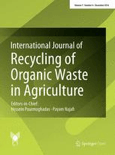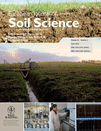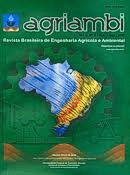
COMPOST SCIENCE & UTILIZATION
Scope & Guideline
Exploring the Interdisciplinary World of Composting.
Introduction
Aims and Scopes
- Organic Waste Management:
Emphasizes innovative methods for managing organic waste, including composting, vermicomposting, and microbial digestion. The journal explores how these practices can enhance soil quality and agricultural productivity. - Soil Health and Fertility:
Investigates the effects of compost and organic fertilizers on soil properties, nutrient availability, and crop yields. The journal highlights studies that contribute to sustainable soil management practices. - Composting Technologies and Techniques:
Focuses on various composting methods, including large-scale and on-farm composting, and the use of technology such as IoT for monitoring compost processes. This area encourages research on optimizing composting efficiency. - Environmental Impact Assessments:
Examines the environmental benefits of composting practices, such as reducing greenhouse gas emissions and improving waste recycling. The journal seeks contributions that assess the ecological footprint of composting. - Innovative Feedstocks and Additives:
Explores the use of diverse organic materials, including agricultural by-products, municipal waste, and novel feedstocks in composting. Research in this area enhances the understanding of feedstock characteristics and their effects on compost quality.
Trending and Emerging
- Integration of Technology in Composting:
There is a rising trend in the application of technology, such as IoT and sensor systems, to monitor composting processes. This integration enhances efficiency, optimizes conditions, and provides data for better decision-making in waste management. - Vermicomposting and Its Benefits:
Research on vermicomposting has surged, showcasing its advantages in enhancing soil fertility and crop yield. This theme reflects a growing recognition of earthworms' role in organic waste recycling and soil health. - Impact of Organic Amendments on Crop Productivity:
Studies increasingly focus on the effects of various organic amendments, including compost and biochar, on crop productivity. This trend highlights the importance of sustainable practices in enhancing agricultural outputs. - Utilization of Waste Materials in Composting:
Emerging research investigates the use of diverse waste materials, such as textiles and food scraps, as feedstocks in composting. This theme underscores the potential for waste valorization and resource recovery in sustainable practices. - Nutrient Dynamics in Composting:
An increasing number of studies are addressing the nutrient dynamics during the composting process, including the availability of essential nutrients for plant growth. This focus is crucial for optimizing compost formulations for agricultural use.
Declining or Waning
- Traditional Composting Methods:
There has been a noticeable reduction in studies focused solely on conventional composting methods, as newer technologies and innovative practices gain prominence. This shift may reflect an increased interest in efficiency and sustainability. - Single-Feedstock Composting Studies:
Research focusing exclusively on single-feedstock composting has decreased. There is a growing trend towards mixed feedstock approaches, which can yield more diverse benefits and improve compost quality. - Basic Composting Process Analyses:
While foundational studies on composting processes remain relevant, the frequency of purely theoretical analyses has diminished. Researchers now tend to focus on applied studies that demonstrate practical implications and real-world applications.
Similar Journals

CANADIAN JOURNAL OF SOIL SCIENCE
Exploring the Depths of Soil Science ExcellenceThe Canadian Journal of Soil Science (ISSN: 0008-4271, E-ISSN: 1918-1841) is a premier publication in the field of soil science, proudly published by Canadian Science Publishing. Established in 1974, this esteemed journal aims to promote high-quality research and insights into the dynamic interactions within soil ecosystems, addressing pressing issues such as soil health, management, and sustainability. With an impressive 2023 category quartile ranking of Q2 in Soil Science and a Scopus ranking placing it in the 52nd percentile, this journal stands out as a key resource for researchers, professionals, and students alike. Although currently not open access, the journal provides valuable content that contributes to advancing the understanding of soil science, an essential discipline for agricultural innovation and environmental stewardship. As we approach its converged years through 2024, the Canadian Journal of Soil Science is poised to continue its pivotal role in disseminating impactful research and fostering a community dedicated to soil science excellence.

Crop Forage & Turfgrass Management
Advancing agricultural practices for a sustainable future.Crop Forage & Turfgrass Management, published by WILEY, serves as an essential platform for researchers, professionals, and students in the fields of agronomy, crop science, plant science, and soil science. With a focus on advancing knowledge in the management of crops, forage systems, and turfgrass, this journal plays a pivotal role in disseminating innovative research and practical applications that drive agricultural sustainability and productivity. Despite its Q3 ranking in various agricultural and biological science categories according to Scopus, it aims to enhance its impact and relevance in the academic community through high-quality publications. As a journal converged from 2015 to 2024, it invites contributions that address contemporary challenges and solutions in crop management, ensuring accessibility to vital knowledge for the advancement of agricultural practices. Situated in the United States, it also reflects the diverse agricultural landscapes and practices of the region, making it a valuable resource for a global audience.

Journal of Material Cycles and Waste Management
Connecting Ideas for a Circular EconomyThe Journal of Material Cycles and Waste Management, published by Springer, stands as a pivotal resource in the fields of material cycles and waste management, addressing critical challenges related to the sustainability of materials and the efficient disposal of waste. With an impact factor reflective of its significant contribution to the scientific community, this journal publishes innovative research that spans a diverse range of topics, from recycling technologies to lifecycle assessment. The journal ranks in the Q2 category for both Mechanics of Materials and Waste Management and Disposal, highlighting its respected position in academia. Operating without open access, the journal seeks to engage researchers, professionals, and students alike, providing a platform to advance knowledge and foster collaboration in the pursuit of sustainable material management solutions. Located in Japan and adhering to a high standard of editorial excellence, the journal is a must-read for those invested in optimizing resource use and minimizing environmental impacts.

International Journal Of Recycling of Organic Waste in Agriculture
Fostering Sustainable Agriculture through Innovative RecyclingInternational Journal of Recycling of Organic Waste in Agriculture is a pioneering open-access journal, established in 2012 and published by the Islamic Azad University, Isfahan-Khorasgan Branch, Iran. With ISSN 2195-3228 and E-ISSN 2251-7715, this journal focuses on innovative research and development in the field of organic waste recycling within agricultural contexts. As indicated by its latest metrics, it holds a respectable ranking in the Q2 quartile in Agricultural and Biological Sciences and Q3 in Waste Management and Disposal for 2023. This positions the journal as a valuable resource for professionals, researchers, and students invested in sustainable agricultural practices and waste management strategies. With its commitment to advancing knowledge and fostering interdisciplinary dialogue, the journal serves as an essential platform for disseminating significant findings that can positively impact environmental sustainability and agricultural productivity worldwide.

Soil Research
Exploring the vital role of soil in our ecosystem.Soil Research, published by CSIRO PUBLISHING, is an esteemed scholarly journal dedicated to advancing the field of soil science, environmental science, and earth-surface processes. With an ISSN of 1838-675X and E-ISSN of 1838-6768, this journal serves as a vital platform for researchers and professionals to disseminate innovative findings and engage with contemporary challenges in soil and environmental management. The journal is recognized for its impactful contributions, as evidenced by its Q2 ranking in 2023 across multiple categories including Earth-Surface Processes, Environmental Science, and Soil Science, reflecting its influence and relevance in these critical academic areas. Operating from its headquarters in Clayton, Victoria, Australia, Soil Research is committed to fostering open access to research, ensuring wider dissemination of knowledge. As it converges toward its future objectives until 2024, the journal aims to provide a forum for diverse perspectives that enhance understanding and stewardship of soil resources, making it an indispensable resource for students, researchers, and industry professionals alike.

Journal of Soil Science and Plant Nutrition
Cultivating knowledge for future agricultural breakthroughs.The Journal of Soil Science and Plant Nutrition, published by SPRINGER INT PUBL AG, is a premier academic journal dedicated to advancing the fields of agronomy, plant science, and soil science. With an impressive Q1 ranking in both Agronomy and Crop Science and Plant Science, alongside a Q2 ranking in Soil Science, this journal stands at the forefront of innovative research and knowledge dissemination. Annually indexed in key databases, it provides a platform for high-quality research articles that explore the complex interactions between soil health and plant nutrition, contributing significantly to sustainable agricultural practices. Although it does not offer open access options, the journal is accessible through various academic institutions and libraries, ensuring a wide readership. With its emphasis on impactful findings, the journal is an essential resource for researchers, professionals, and students aiming to further their understanding and application of soil and plant science in an ever-evolving global context.

EUROPEAN JOURNAL OF SOIL SCIENCE
Connecting Science to Soil Sustainability ChallengesEUROPEAN JOURNAL OF SOIL SCIENCE, published by Wiley, stands as a leading platform in the field of soil science, recognized for its contributions to the understanding of soil ecology, management, and sustainability. With an impressive impact factor and a distinguished Q1 ranking in Soil Science, this journal has recently ranked 23rd out of 159 in its category on Scopus, placing it in the 85th percentile among its peers. Covering a wide array of topics as it converges into the future, from 1994 to 2024, the journal aims to disseminate groundbreaking research and innovative methodologies that address the pressing challenges of soil degradation and environmental sustainability in Europe and beyond. Although it is not an open access journal, the EUROPEAN JOURNAL OF SOIL SCIENCE remains a vital resource for researchers, professionals, and students seeking to deepen their understanding and explore the latest advancements in soil science.

Revista Brasileira de Engenharia Agricola e Ambiental
Advancing Sustainable Solutions in Agriculture and EnvironmentRevista Brasileira de Engenharia Agricola e Ambiental, published by the Universidade Federal de Campina Grande, serves as a pivotal platform for researchers and professionals in the fields of agricultural and biological sciences, agronomy, and environmental engineering. With an open-access policy since 2000, this journal aims to foster global dissemination of innovative research and practices, ensuring that high-quality findings are accessible to all. Operating in Brazil, it holds notable rankings, including Q2 in the categories of Agricultural and Biological Sciences (miscellaneous) and Agronomy and Crop Science, indicating its strong academic impact and influence within these fields. As of 2023, it ranks #68 out of 193 in Agricultural and Biological Sciences and #188 out of 406 in Agronomy and Crop Science, representing its commitment to advancing scientific knowledge. The journal primarily focuses on publishing studies that address challenges in agricultural engineering and environmental sustainability, making it an essential read for students, researchers, and professionals who are dedicated to innovation and excellence in these dynamic fields.

Transactions of the ASABE
Exploring the intersection of biology and engineering.Transactions of the ASABE is a premier journal published by the American Society of Agricultural and Biological Engineers, specializing in innovative research and practical applications in the fields of agricultural and biological engineering. With an ISSN of 2151-0032 and E-ISSN 2151-0040, this journal has established a vital niche in disseminating high-quality scholarly content that addresses the complex challenges faced in agriculture and biological systems. The journal operates under an open access model, facilitating broad dissemination of research findings to a global audience. This commitment to accessibility is reflected in its coverage of diverse topics, including agriculture, soil science, food science, and environmental engineering. Although the journal's coverage in Scopus was discontinued in 2021, it once ranked among the top in its categories, indicating its significant contribution to advancing knowledge in these essential fields. Researchers, practitioners, and students are encouraged to engage with the Transactions of the ASABE to stay abreast of developments and foster collaboration in promoting sustainable engineering solutions.

ENVIRONMENTAL ENGINEERING SCIENCE
Pioneering research for a sustainable future.ENVIRONMENTAL ENGINEERING SCIENCE is a leading journal published by MARY ANN LIEBERT, INC that provides a platform for pioneering research in the fields of environmental chemistry, pollution control, and waste management. With an ISSN of 1092-8758 and an E-ISSN of 1557-9018, this peer-reviewed journal aims to disseminate high-quality scientific studies that address critical environmental challenges. As evidenced by its 2023 category quartile rankings, it holds a notable position at Q3 in Environmental Chemistry and Pollution and Q2 in Waste Management and Disposal, highlighting its relevance and impact in these domains. Spanning over two decades from 1997 to 2024, the journal is dedicated to fostering innovations and promoting rigorous scholarship that can contribute significantly to sustainable environmental practices globally. Authors and researchers are encouraged to engage with this essential resource, which offers Open Access options to enhance the visibility and reach of their work. For those interested in advancing their understanding and practice within the environmental sciences, ENVIRONMENTAL ENGINEERING SCIENCE is an indispensable journal to consider.